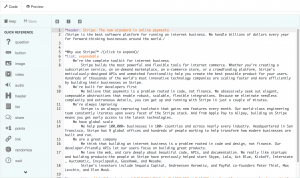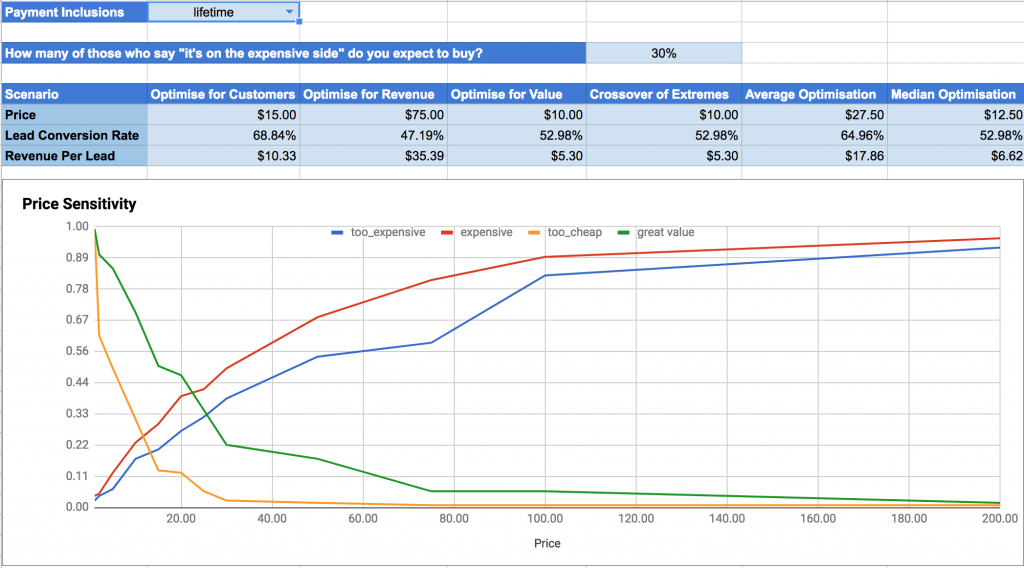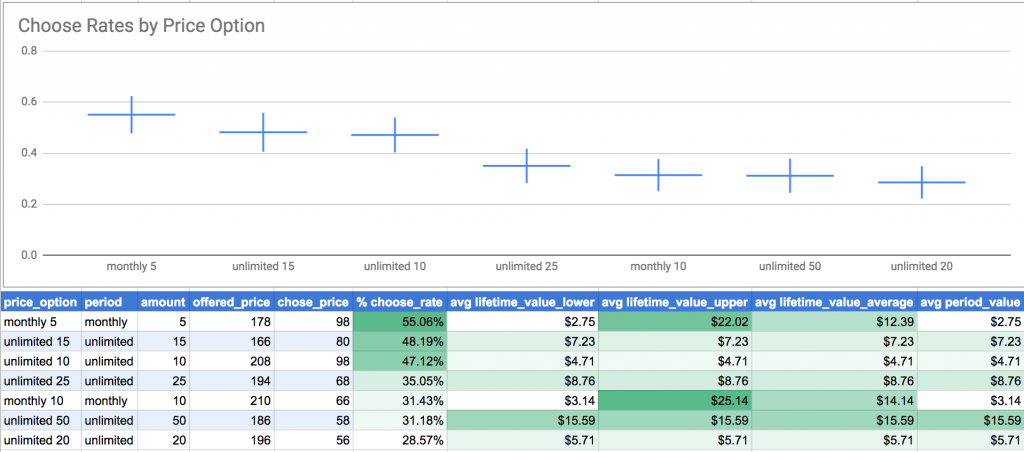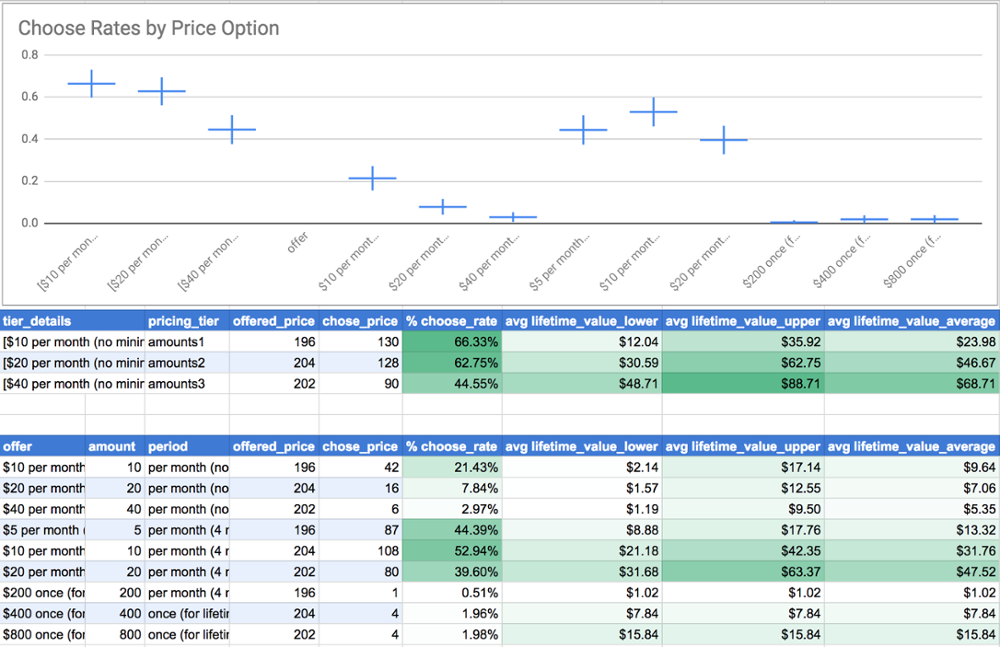Your pricing model is probably one of the most important things to get right with your product or service.
Getting it wrong is a leading cause of business failure: if people aren’t buying what you’re selling at a price that’s profitable, it’s a recipe for failure.
Even if you can become sustainable as an organisation, there’s a huge opportunity cost by not optimising your pricing – it leaves money on the table that a competitor will gladly take to out-invest, out-market and outperform you.
At Positly we work with new ventures who are working on their pricing for the first time as well as existing businesses revisiting their pricing – here we’ll share what we’ve learned.
Note: this post is packed full of so many templates and strategies that it may be daunting. Don’t be afraid to take what you will from it and just experiment with some of it. Remember, you don’t have to do everything, any attempt to improve your pricing strategy is better than none!
Our approach to pricing
Sometimes pricing can seem fairly easy, especially for physical products. For example, I could sell you an apple for roughly what it cost me, plus a little margin for my labour. However, many products and services (especially digital ones) simply couldn’t work that way – nor should they.
Digital products generally have huge overheads (building the thing) and then over time they can have huge margins. This is also why they can be so profitable, if they succeed.
Key to success with any enterprise is getting the pricing strategy right. That’s why we often recommend using value-based pricing not cost-based pricing (unless you’re in a low margin, high volume sector such as fast moving consumer goods).
Value-based pricing is simply asking the questions such as:
- How valuable is this to your customer?
- How costly is the problem this solves?
- How happy does this make them feel?
- How much are they willing to pay?
- At what price would it feel suspiciously “too good to be true”?
- At what point do they think the product is great value for money?
The ideal situation is that your customers come away feeling like they’ve got a great deal, and you have a price that enables you to meet your goals (be it growth, sustainability, or other aspirations).
There are a few industry standards for this, but a model we’ve had success with is:
- Step 1. Decide on your goals
- Step 2. Define your target market
- Step 3. Describe your product to your target market
- Step 4. Exploratory pricing study using the Price Sensitivity Meter
- Step 5. Develop models and conduct single-question pricing studies
- Step 6. Combine the best offers into tiered pricing studies
- Step 7. Simulate your pricing models
Taking the time to properly experiment with your pricing and producing strong models of your business will increase your chances of success many times over – this could be the single most important difference between success and failure.
The Iterative Research Process
This article includes many references to Positly for participant recruitment, Google Sheets for analyzing results and GuidedTrack for building activities. These services are all easy to use and incredibly useful, so if you haven’t signed up for them yet, I recommend you do so now so you can follow along and look at the examples and templates.
This diagram illustrates how we use these tools in our iterative research process of designing the study, building the study, delivering the study to participants, and analyzing the data.
Step 1. Decide on your goals
We don’t always have the same goals when it comes to pricing. Some people want to have a low-effort lifestyle business, so they will try to maximise revenue per customer. Other people want to scale big, and they’ll optimise for growth, while many businesses over the long term will probably optimise for profitability.
On the other hand, there is a growing movement of “for-purpose” businesses that will optimize for sustainability and social impact. For this type of organization, profitability may not be the single biggest factor – it could be reach, impact, or some other metric.
The pricing structures you decide to test will also depend on the type of business you are running. The most common are:
- Subscriptions (like most magazines)
- One-time payments (like most physical products)
- Transaction fees (percent or dollar – like ticket merchants)
Have a look at what similar products and competitors are doing. However, you may be surprised at how much you can innovate on pricing models. A huge portion of the software and now many physical products have shifted from one-time payments to subscription models, and the early movers have made huge gains in the market.
The way you frame your prices matters. For example, Monthly 1k by AppSumo prices their course at $360 per year, allows $35 installments over 12 months and reframes it by telling you that you’re only paying $1.15 per day.
Take a moment to think of a few ways to frame your prices, and then we’ll walk you through creating studies to test them.
We will provide you with some study templates throughout this post. However, when building your own studies from these templates, it’s important to consider how you will use the data later in your analysis.
For example, if you are asking about a subscription model, ask how long they would expect to keep the subscription at that price or how long they have kept the subscription of similar products at similar prices.
If your business model requires organic growth, ask how many people would they refer to your product per month if they were customers.
I strongly recommend that you don’t start conducting studies until you’ve read step 7 and perhaps even built a few pricing models or simulations first. If you do this, then you can update your models along the way as you start to get better information from your studies.
Step 2. Define your target market
It’s essential that you know who your product is for. Your product has to be solving problems for someone otherwise it’s no good to anyone!
If your product aims to serve multiple customer personas, you’ll need to study them separately (segment them in your analysis, at the very least). If this is the first time you’re selling the product, you’ll probably want to focus on the group that you think is easiest to sell to initially and then later expand to harder-to-sell-to groups.
Next, determine appropriate screening conditions for your target market. Often, these could be quite simple, such as age and gender. Other times, it could be more complex, such as “people suffering from depression,” and this may require special screeners (such as the psychological assessment PHQ-2).
Using Positly, you can pick standard demographic attributes for targeting or carry out a screening activity before your main study.
If your target market is difficult to screen for or your budget is insufficient for a pre-screening round, you can always try a “transparent screener” (the participants see all the conditions for the study upfront and then opt-in by declaring that they meet the conditions).
For screening tips, contact us using the chat button on this page or subscribe to this blog (below). We’ll soon post about screening participants for your study.
Step 3. Describe your product
It should go without saying that if you are going to be studying the value of your product to customers it is really essential that they understand precisely what the value is to them.
Ideally, you will have some kind of prototype (at least some images or diagrams) and a very clear description of the problem (or problems) your product solves.
If you don’t have a digital prototype yet that you can link people to, I recommend building a program in GuidedTrack that walks someone through the product. If you use GuidedTrack to build your surveys later on, then you can reference this product description program in your pricing studies. See this example of a product description program.
Step 4. Exploratory pricing study
Now that you have a good description and prototype, you can start the exploratory pricing studies.
For this, we recommend using the Van Westendorp Price Sensitivity Meter (PSM). The PSM is a methodology for determining consumer price preferences, introduced in 1976 by Dutch economist Peter van Westendorp.
It asks just four basic questions:
- At what price would you consider the product to be so expensive that you would not consider buying it? (Too expensive)
- At what price would you consider the product to be priced so low that you would feel the quality couldn’t be very good? (Too cheap)
- At what price would you consider the product starting to get expensive, so that it is not out of the question, but you would have to give some thought to buying it? (Expensive/High Side)
- At what price would you consider the product to be a bargain—a great buy for the money? (Cheap/Good Value)
You can then produce a nice chart that shows you the sweet spots where your price is most acceptable to most people and how you can tweak it for your different goals.
To make your life easier, we’ve built two programs for you that you can access in GuidedTrack using the *program keyword and a spreadsheet that you can copy in Google Sheets.
Van Westendorp Pricing Sensitivity templates:
- Study Template Program: demo, customize
Program to test only a single payment inclusion - Experiment Template Program: demo, customize
Program to test multiple payment inclusions - Example Experiment Program: preview, copy
Program that runs the experiment with an example product so you can copy it - Analysis Spreadsheet: preview, copy
Spreadsheet to analyse the results
To conduct this study with our template, simply create a GuidedTrack program with the variables product_name, product_description, and payment_inclusions and then trigger the program with the *program keywords (e.g., “*program: Van Westendorp Pricing Experiment”).
As you can see in the code of our example program, we simply introduce the activity to the participant and then start the program after setting our custom variables.
Once you’ve set up your survey program to your liking and given it a thorough test (including a dry run to estimate time for completion), you can copy the share link, open up your Positly dashboard, and create a new run with your ideal audience targeting and using the GuidedTrack survey program as your activity link in Positly.
As soon as the data has entered GuidedTrack, you can export it, make a copy of the analysis spreadsheet, and then import it into the “Imported Data” tab of the spreadsheet.
Voila! Now sitting within the bulls eye drawn by these lines is a starting point for your pricing research that you can start to use to develop offers.
Step 5. Binary pricing experiments
If you have completed step 4, you will have some data on a few different pricing models and how much people value your product. With this data, you can develop some pricing models and test them each with a single-question pricing study (they will have only “yes” or “no” as options).
The idea behind this is to simulate the conversion rate of someone who lands on your website and is offered your product. Please bear in mind, however, that a pricing study is still different from real-world scenarios. In the real world, people are likely to browse around a bit and aren’t put on the spot with a yes or no question.
The data here is likely to show you the relative acceptance of different prices (e.g., option 1 is 20% more preferable) and not the absolute conversion rates that you will find in the real world (e.g., 1 in 3 people who visit the homepage will buy the product).
This type of study can really help to segment the data by interest level (e.g., “How likely would you be to buy a product like this?”) or customer type (e.g., business vs. personal). Make sure you also ask any questions that may be relevant to your future business analysis (e.g., “On average, how many months have you kept subscriptions for similarly priced products?”).
To make your life easier we’ve built two programs for you that you can access in GuidedTrack using the *program keyword and a spreadsheet that you can copy in Google Sheets.
Binary Pricing templates:
- Study Template Program: demo, customize
Program to test only a single payment option - Experiment Template Program: demo, customize
Program to test multiple payment options - Example Experiment Program: preview, copy
Program that runs the experiment with an example product so you can copy it - Analysis Spreadsheet: preview, copy
Spreadsheet to analyse the results
To conduct this study with our template, simply create a program with the variables product_name, product_description, period, and amounts. I also recommend customizing the additional variables, such as the lifetime_periods_upper and the lifetime_periods_lower, so that you can automatically calculate how valuable the customer could be.
Again, you can look at the code of our example program and see how we introduce the activity to the participant and then start the program after setting our custom variables. In our example, we use the *experiment function to test two different periods evenly.
Run the experiment with your target audience on Positly and then import the data into your own copy of our analysis spreadsheet to gear up for the final round of pricing studies.
Step 6. Test your pricing tiers
At this point, I hope you will have a strong idea of what’s resonating with your potential customers and what strategy you’re going to use. Now, you can start testing tiers of pricing against each other.
This is a good way of testing the broader pricing strategy, such as whether you use decoy/anchoring prices and whether you need different options targeted towards different types of customers (e.g., different feature sets or subscription lengths).
To make your life easier, we’ve built two programs for you that you can access in GuidedTrack using the *program keyword and a spreadsheet that you can copy in Google Sheets.
Pricing tier templates:
- Study Template Program: demo, customize
Program to test only a single pricing tier - Experiment Template Program: demo, customize
Program to test multiple pricing tiers - Example Experiment Program: preview, copy
Program that runs the experiment with an example product so you can copy it - Analysis Spreadsheet: preview, copy
Spreadsheet to analyse the results
If you’ve followed the last few steps, you should be a pro at customizing the GuidedTrack programs for yourself, running the studies on Positly, and analyzing the results in Google Sheets.
Once you’ve completed the studies and analysis, lo and behold, you have something that looks very much like a successful pricing strategy ready to start testing with real users!
But first… make sure what you go forward with really makes business sense in simulations.
Step 7. Simulate your pricing models
I recommend starting to build your simulation models right at the beginning and refining them along the way, but if you haven’t done it yet, you really must do it before going live.
A model can be really simple and built into your favorite spreadsheet program, or it can be more advanced. A simple model can take a few seconds to a few hours to build and is really worthwhile. Even complicated modeling can be more straightforward than you think if you use the right software, the right templates, or follow the right expert advice.
During the modeling, it’s a great opportunity to sanity-check the studies’ results. If something seems odd (e.g., people are more willing to pay $25 than $20), then it may just require further studies to either confirm or disconfirm (odd doesn’t necessarily mean false).
Have a look through some of my templates below as a starting point. Ideally, you will flesh your models out with as many relevant variables and the best estimates you have for them as possible so that you can then start to refine them.
When it comes to modeling, this is the exact mentality to keep in mind:
“everything should be made as simple as possible, but not simpler”
Simple spreadsheet modeling
Spreadsheets are the bread and butter of business. Here are a couple of spreadsheet models that took me a few minutes to put together:
Monte Carlo simulation modeling
Often, you can get a better idea of the possible and probable outcomes by using number ranges (upper and lower estimates) instead of simple average estimates. If you’d like to use number ranges, I strongly recommend the tool Guesstimate, which runs 5,000 Monte Carlo simulations (a popular forecasting method that was inspired by the simulations required for the Manhattan Project when developing the atomic bomb).
Here are three Guestimate models that took me roughly 15 minutes each to build:
- Subscription Pricing Model Simulation
- Lifetime Pricing Model Simulation
- Market Sizing and Market Share Model Simulation
The importance of simulations and why they are crucial can be demonstrated in this lifetime pricing model simulator.
At first glance, the $25 price seems like a better option with a higher revenue per visitor. However, once you account for organic growth and churn rates, the higher value of scenario 4 ($25 price) doesn’t outpace the cost of its lower signup rate and is eventually overtaken by scenario 2 ($15), which has a signup rate of ~42% vs. ~35%.
Secondly, the one-off price in scenario 5 has the highest revenue in this model, but chasing revenue alone could interfere with the organization’s customer growth goals.
The prices you choose will have to make long-term sense for the business, and modeling with this style of simulation is one of the best ways of avoiding those mistakes.
Go to market… and keep testing!
Getting pricing right is difficult, especially for completely new ventures.
If you are clear on your pricing goals, who your customers are, what you are selling them, and how they feel about different pricing models, you will be in a strong position to go to market (or change your offering).
By studying the issue thoroughly, you can increase your odds of success many times. It’s a discipline that more new businesses would benefit from.
If you would like help with your pricing studies, please don’t hesitate to get in touch using the chat window on the screen.
If you have any questions, suggestions, feedback, or experiences, please join us in the comments below. Feel free to subscribe to this blog to get notified of future updates.
Still interested in pricing strategies? I recommend these three articles: 8 Pricing Strategies for Your Digital Product, How to Price Your Products and How to Price Digital Products.








